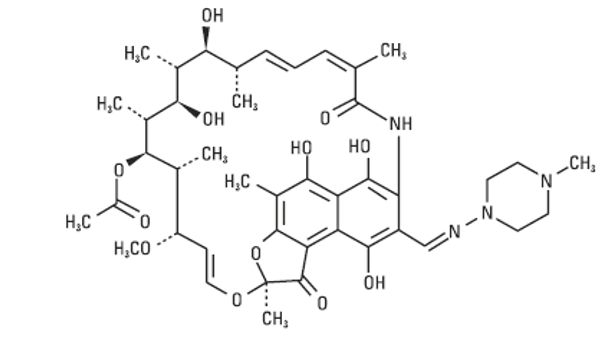The Role of Rifampin in Bone and Joint Infections
In the latest column from the Society of Infectious Diseases Pharmacists (SIDP), here is a discussion on the use of rifampin as an adjunctive antibiotic treatment for patients with diabetic foot osteomyelitis.
Rates of diabetic foot infection (DFI) continue to rise consistent with the increase in prevalence of diabetes worldwide. Diabetic foot infection can often penetrate to bone, and it is in this suspicion or diagnosis of diabetic foot osteomyelitis (DFO) where rifampin may be beneficial as an adjunctive antibiotic treatment. Compared to the 2012 IDSA guidelines, an updated guideline from the International Working Group on the Diabetic Foot (IWGDF) in 2020 more prominently discusses rifampin as an agent that may be effective for biofilm, hardware, osteomyelitis, as well as it’s more traditional use in staphylococcal infections.1-2

Rifampin is a semi-synthetic, lipophilic compound with a high molecular weight (822.94 g/mol). Rifampin binds to bacterial RNA polymerase on the B subunit, blocking DNA transcription into RNA.3-5
Rifampin is mechanistically an option for osteoarticular and hardware infections for several reasons, as noted in the bullets below:5-6
- Rifampin is bactericidal for susceptible staphylococcal strains (minimal inhibitory concentration [MIC] <1 μg/mL in vitro) and the MIC is usually about 0.06 μg/mL.
- Rifampin diffuses well within bacterial biofilms, where it remains bactericidal
- Rifampin provides intracellular killing. The ability of rifampin to diffuse very readily within cells results in activity against intracellular organisms located within leukocytes and osteoblasts.
- Rifampin acts on dormant bacteria with very low division rates, due to its inhibition of bacterial RNA polymerase.
This mechanistic data is supported by an in vitro study that showed the number of MRSA cells per gram of bone in rat animal models was lower in those receiving rifampin containing ciprofloxacin or vancomycin combinations.7 Due to rapid resistance development, rifampin must always be given with a second active antimicrobial.5

Clinical Evidence
Clinical data for diabetic foot osteomyelitis is limited, but compelling.8 One recent observational cohort study among VA patients included the largest sample of diabetic foot infections with osteomyelitis to date. In patients who were treated with antibiotics without surgery (n=6174), those treated with adjunctive rifampin (n=130) had a significantly lower rate of mortality and amputation within two years of diagnosis compared to those treated without rifampin (OR: 0.65, p=0.04).8 Authors and collaborators on this cohort study are now currently conducting a randomized controlled trial. This study is known as VA INTREPID and results are eagerly awaited, but pending completion around January 2024.9
Other clinical uses of rifampin in osteoarticular infection include:
Prosthetic joint infection caused by Staphylococci species
The 2013 IDSA guidelines on the diagnosis and management of prosthetic joint infection recommend companion therapy with rifampin when paired with debridement and retention of the prosthesis or after one-stage exchange.10
Native vertebral osteomyelitis caused by S aureus
The 2015 IDSA clinical practice guidelines for the diagnosis and treatment of native vertebral osteomyelitis in adults recommend levofloxacin plus rifampin as alternative treatment options for both oxacillin susceptible and resistant S aureus.11
While rifampin has strong mechanistic and in vitro data, as well as data supporting its adjunctive use for other osteoarticular infections, there is still limited clinical evidence for use in DFO. This new data should be balanced against rifampin’s adverse effect profile including gastrointestinal discomfort plus propensity for drug interactions.
References
- Lipsky BA, Berendt AR, Cornia PB, Pile JC, Peters EJG, Armstrong DG, Deery HG, Embil JM, Joseph WS, Karchmer AW, Pinzur MS, Senneville E. 2012 Infectious Diseases Society of America Clinical Practice Guideline for the Diagnosis and Treatment of Diabetic Foot Infections. Clinical Infectious Diseases. 2012; 54(12): e132–e173. https://doi.org/10.1093/cid/cis346.
- Lipsky BA, Senneville É, Abbas ZG, Aragón-Sánchez J, Diggle M, Embil JM, Kono S, Lavery LA, Malone M, van Asten SA, Urbančič-Rovan V, Peters, EJG on behalf of the International Working Group on the Diabetic Foot (IWGDF). Guidelines on the diagnosis and treatment of foot infection in persons with diabetes (IWGDF 2019 update). Diabetes/Metabolism Research and Reviews. 2020; 36(S1):e3280. https://doi.org/10.1002/dmrr.3280.
- Rifampin structure image. https://dailymed.nlm.nih.gov/dailymed/image.cfm?name=rifampin-for-injection-usp-1.jpg&id=620544
- Wehrli W. Rifampin: Mechanisms of Action and Resistance. Reviews of Infectious Diseases. 1983; 5: S407–S411. http://www.jstor.org/stable/4453139.
- Coiffier G, Albert JD, Arvieux C, Guggenbuhl P. Optimizing combination rifampin therapy for staphylococcal osteoarticular infections. Joint Bone Spine. 2013; 80(1):11–17. https://doi.org/10.1016/j.jbspin.2012.09.008.
- Liu C, Bayer A, Cosgrove SE, Daum RS, Fridkin SK, Gorwitz RJ, Kaplan S, Karchmer AW, Levine DP, Murray BE, Rybak MJ, Talan DA, Chambers HF. Clinical Practice Guidelines by the Infectious Diseases Society of America for the Treatment of Methicillin-Resistant Staphylococcus aureus Infections in Adults and Children. Clinical Infectious Diseases. 2011; 52(3):e18–e55. https://doi.org/10.1093/cid/ciq146.
- Henry N, Rouse M, Whitesell A., McConnell M, Wilson W. Treatment of methicillin-resistant Staphylococcus aureus experimental osteomyelitis with ciprofloxacin or vancomycin alone or in combination with rifampin. Am J Med. 1987; 82(4A):73–75.
- Wilson BM, Bessesen MT, Doros G, Brown ST, Saade E, Hermos J, Perez F, Skalweit M, Brad Spellberg B, Bonomo RA. Adjunctive rifampin therapy for diabetic foot osteomyelitis in the Veterans Health Administration. JAMA Network Open. 2019; 2(11):e1916003. doi:10.1001/jamanetworkopen.2019.16003.
- Bessesen MT, Doros G, Henrie AM, Harrington KM, Hermos JA, Bonomo RA, Ferguson RE, Huang GD, Brown ST. A multicenter randomized placebo controlled trial of rifampin to reduce pedal amputations for osteomyelitis in veterans with diabetes (VA INTREPID). BMC Infectious Diseases. 2020; 20:23. https://doi.org/10.1186/s12879-019-4751-3.
- Osmon DR, Berbari EF, Berendt AR, Lew D, Zimmerli W, Steckelberg JM, Rao N, Arlen Hanssen A, Wilson WR. Diagnosis and Management of Prosthetic Joint Infection: Clinical Practice Guidelines by the Infectious Diseases Society of America. Clinical Infectious Diseases. 2013; 56(1): e1–e25. https://doi.org/10.1093/cid/cis803.
- Berbari EF, Kanj SS, Kowalski TJ, Darouiche RO, Widmer AF, Schmitt SK, Hendershot EF, Holtom PD, Huddleston PM, Petermann GW, Osmon DR. 2015 Infectious Diseases Society of America (IDSA) Clinical Practice Guidelines for the Diagnosis and Treatment of Native Vertebral Osteomyelitis in Adults. Clinical Infectious Diseases. 2015; 61(6): e26–e46. https://doi.org/10.1093/cid/civ482.
